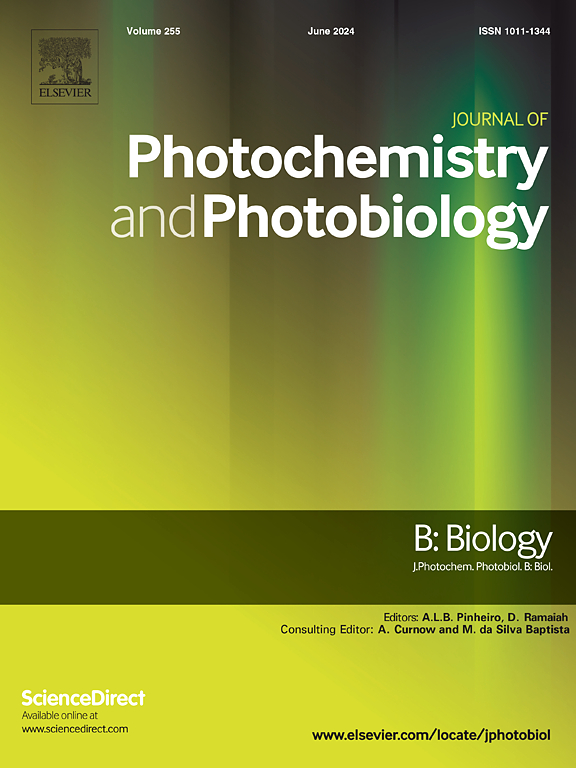丹酚酸B通过激活NRF2和清除ROS来防止uvb诱导的HaCaT细胞衰老和皮肤老化
IF 3.7
2区 生物学
Q2 BIOCHEMISTRY & MOLECULAR BIOLOGY
Journal of photochemistry and photobiology. B, Biology
Pub Date : 2025-03-01
DOI:10.1016/j.jphotobiol.2025.113139
引用次数: 0
摘要
长时间暴露在阳光下会导致皮肤光老化。表皮,皮肤的最外层,保护身体免受环境的侵害。本研究探讨了丹参生物活性物质丹酚酸B (salvianolic acid B, Sal-B)对光老化的保护作用,并探讨了其具体机制。方法在体外用不同剂量的Sal-B处理HaCaT细胞,然后进行UVB光照射。HaCaT细胞的评估包括细胞衰老、凋亡细胞比例、活性氧(ROS)水平、线粒体功能、超氧化物歧化酶活性、基因和蛋白质表达。采用免疫荧光标记、核因子红细胞2相关因子2 (NRF2)敲除、Western blotting分析。为了评估Sal-B在体内对皮肤光老化的保护作用,我们采用了裸鼠模型和离体人皮肤模型。结果在体外实验中,Sal-B显著激活NRF2,清除ROS,保护线粒体功能,抑制核因子κ B和丝裂原活化蛋白激酶途径。最终,Sal-B阻止了uvb诱导的光老化和角质细胞凋亡。在体内,我们证实了Sal-B能改善UVB照射后裸鼠的皮肤皱纹和表皮厚度,其效果比维甲酸更明显。我们发现了Sal-B对uvb诱导的皮肤光老化的预防作用,并揭示了其作为NRF2信号通路的调节因子的潜力。本文章由计算机程序翻译,如有差异,请以英文原文为准。

Salvianolic acid B protects against UVB-induced HaCaT cell senescence and skin aging through NRF2 activation and ROS scavenging
Background
Prolonged sunlight exposure can cause skin photoaging. The epidermis, the outermost layer of the skin, protects the body from the environment. This study explored the protective effect of salvianolic acid B (Sal-B), a bioactive compound from Salvia miltiorrhiza, against photoaging and examined its specific mechanism.
Methods
In vitro, HaCaT cells were treated with various doses of Sal-B before ultraviolet B (UVB) light exposure. Assessments in HaCaT cells included cellular senescence, apoptotic cell ratio, reactive oxygen species (ROS) levels, mitochondrial function, superoxide dismutase activity, and gene and protein expression. Immunofluorescence labeling, nuclear factor erythroid 2-related factor 2 (NRF2) knockdown, and Western blotting analysis were used. To assess Sal-B's protective effects on skin photoaging in vivo, we employed a nude mouse model and an ex vivo human skin model.
Results
In vitro, Sal-B significantly activated NRF2, scavenged ROS, protected mitochondrial function, and inhibited nuclear factor kappa B and mitogen-activated protein kinase pathways. Ultimately, Sal-B prevented UVB-induced photoaging and keratinocyte apoptosis. In vivo, we confirmed that Sal-B improved skin wrinkles and epidermal thickness in nude mice following UVB irradiation, displaying greater efficacy than tretinoin.
Conclusion
We identified the preventive implications of Sal-B against UVB-induced senescence in skin photoaging and revealed its potential as a regulator of the NRF2 signaling pathway.
求助全文
通过发布文献求助,成功后即可免费获取论文全文。
去求助
来源期刊
CiteScore
12.10
自引率
1.90%
发文量
161
审稿时长
37 days
期刊介绍:
The Journal of Photochemistry and Photobiology B: Biology provides a forum for the publication of papers relating to the various aspects of photobiology, as well as a means for communication in this multidisciplinary field.
The scope includes:
- Bioluminescence
- Chronobiology
- DNA repair
- Environmental photobiology
- Nanotechnology in photobiology
- Photocarcinogenesis
- Photochemistry of biomolecules
- Photodynamic therapy
- Photomedicine
- Photomorphogenesis
- Photomovement
- Photoreception
- Photosensitization
- Photosynthesis
- Phototechnology
- Spectroscopy of biological systems
- UV and visible radiation effects and vision.

 求助内容:
求助内容: 应助结果提醒方式:
应助结果提醒方式:


